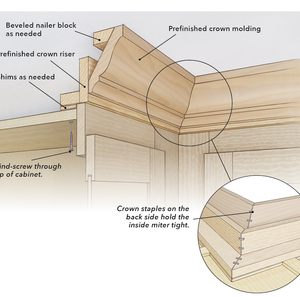Stain Panel Door Tongues
Prevent bare wood from being exposed when staining a panel door by applying a heavy coat of stain and using a compressor hose.

To accommodate a different rate of expansion and contraction between a panel and the stiles and rails in a five-piece cabinet door, the panel is meant to float within the frame. Changes in temperature and humidity levels can cause the panel to shift within the frame, which is normal. However, when staining a panel door, if the tongues on the panel don’t get coated with stain, when the panel does shift within the grooves of the frame, bare wood on those tongues might be exposed. The darker the stain, the more noticeable the bare wood will be.
To avoid this, I apply a heavy coat of stain around the perimeter of the panel and use a blower on the end of a compressor hose to shoot the stain into the grooved area of the door. To prevent blasting stain all over my shop, I hold a towel as a backstop as I move along the perimeter of the door. To prevent water in the air hose from creating a blotchy finish, make sure that the compressor you use is equipped with a reliable moisture filter/trap.
—Kyle Hansen, Rosemount, Minn.
Illustration by Charles Miller




























